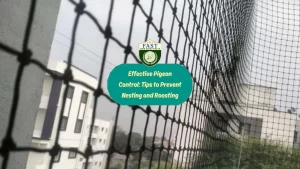Introduction:
Pigeons, often considered as symbols of urban environments, can also be a source of various issues and challenges. While they may seem harmless or even charming at first glance, pigeons can create significant problems in both urban and rural settings. From health hazards to property damage, their presence can pose numerous concerns for individuals and communities alike. In this comprehensive guide, we explore the various issues caused by pigeons and provide insights into effective management strategies.
Health Hazards:
One of the most significant concerns associated with pigeons is the potential health hazards they pose. Pigeons are known transmitter of various diseases, that includes:
Histoplasmosis: A fungal infection caused by Histoplasma capsulatum, which can be contracted by inhaling spores found in pigeon droppings. Symptoms may include fever, cough, and respiratory issues.
Cryptococcosis: Another fungal infection transmitted through pigeon droppings, leading to respiratory problems and, in severe cases, meningitis.
Salmonellosis: Pigeon droppings can harbor Salmonella bacteria, causing food poisoning, gastroenteritis, and other gastrointestinal illnesses in humans.
Ectoparasites: Pigeons can host various ectoparasites such as fleas, mites, and ticks, which may transmit diseases to humans and pets.
Property Damage:
Pigeons can also cause significant damage to buildings, structures, and other property. Some common issues include:
Corrosion: Pigeon droppings contain uric acid, which can corrode metal surfaces, including roofs, gutters, and air conditioning units, leading to structural damage over time.
Fouling: Pigeon droppings deface buildings and outdoor spaces, affecting their aesthetic appeal and potentially reducing property values.
Clogged Drains: Accumulation of pigeon droppings and nesting materials can block gutters and drains, leading to water damage and flooding.
Nesting Habits: Pigeons often build nests in and around buildings, causing blockages in ventilation systems, chimneys, and guttering, which can compromise functionality and pose fire hazards.
Damage to Agricultural Crops: In rural areas, flocks of pigeons can cause significant damage to agricultural crops, resulting in economic losses for farmers.

Public Nuisance:
Pigeons are notorious for creating public nuisance problems in urban environments:
Noise Pollution: Pigeons can be noisy birds, particularly during mating season, when they coo and flap their wings, causing disturbances to residents and workers in urban areas.
Droppings and Debris: Pigeon droppings not only pose health risks but also create unsightly messes on sidewalks, benches, statues, and other public amenities, requiring frequent cleaning and maintenance efforts.
Aggressive Behavior: In crowded urban spaces, pigeons may exhibit aggressive behavior, particularly when competing for food sources, which can intimidate pedestrians and disrupt outdoor activities.
Public Safety Concerns: Pigeon droppings on walkways and staircases can create slippery surfaces, increasing the risk of slips and falls, especially in high-traffic areas.
Environmental Impact:
Pigeons can also have negative effects on the environment:
Displacement of Native Species: In some cases, feral pigeon populations can outcompete native bird species for food and nesting sites, leading to declines in biodiversity.
Seed Dispersal: Pigeons consume a variety of seeds and grains, which they may spread to different locations, potentially contributing to the spread of invasive plant species.
Management Strategies:
Given the multitude of issues associated with pigeons, effective management strategies are essential:
Habitat Modification: Implement measures to deter pigeons from roosting and nesting on buildings, such as installing bird spikes, Pigeon netting, or wire mesh.
Sanitation Practices: Maintain clean and hygienic environments to discourage pigeon habitation and reduce the risk of disease transmission.
Repellents and Deterrents: Use auditory, visual, or tactile repellents to deter pigeons from roosting and nesting areas, including ultrasonic devices, reflective surfaces, and physical barriers.
Population Control: Implement humane population control measures, such as pigeon contraception or relocation programs, to manage feral pigeon populations effectively.
Public Education: Raise awareness among the public about the potential health hazards and nuisance issues associated with pigeons, encouraging responsible behavior and cooperation in pigeon management efforts.
Conclusion:
While pigeons may be a common sight in urban and rural landscapes, their presence can give rise to various issues and challenges. From health hazards to property damage, public nuisance problems to environmental impacts, pigeons can pose significant concerns for individuals, communities, and ecosystems. By understanding these issues and implementing effective management strategies, we can mitigate the negative effects of pigeon populations and foster healthier, safer, and more sustainable environments for all.






